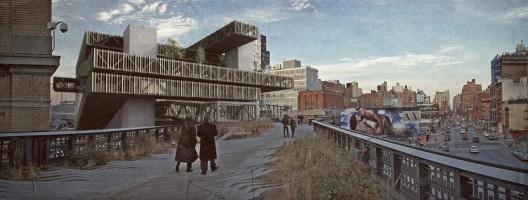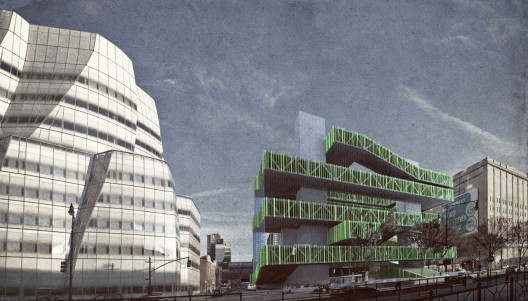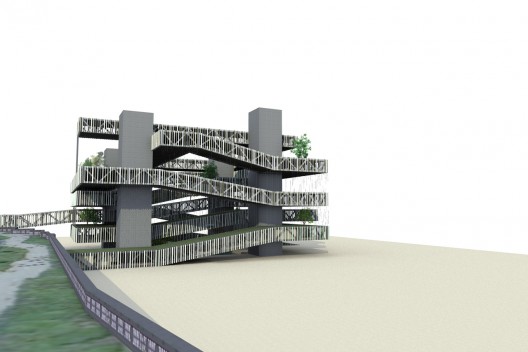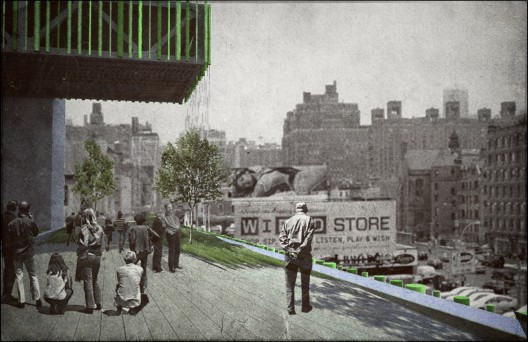By Alison FurutoClick here for the original article.
 Courtesy of TARQUITECTOS
Courtesy of TARQUITECTOS
The Green Carceri, designed by TARQUITECTOS, arises as a natural extension of the High Line Park, connecting himself with the High Line and flying over the river, thus enabling a continuation of the public space underneath with the neighborhood to the height of the street and the docks. Winding around a series of vertical communication cores, the building allows both internal transit users and visitors to descend to the level of the street without having to enter the building. More images and architects’ description after the break.
 Courtesy of TARQUITECTOS
Courtesy of TARQUITECTOS
We understand that the High Line Park can be considered as a real plant structure in the city, that with its consolidation has branched out and created new shoots and buds at their ends in the form of building program and public space. The Green Carceri would be one of these buds or branches, which are able to maintain the configuration of the branch that develops original but particularly adapted to a given functional and programmatic needs. The mixed program of the building includes a botanical research center, a library and a residential area, inserting a suspended mass of vegetation in an urban green space of significant size.
 Courtesy of TARQUITECTOS
Courtesy of TARQUITECTOS
The proposed building, like the High Line and the orthogonal of the city, is essentially linear, although this linearity revolves around a cloistered space that is reached by going through what we like to call reconstructed labyrinth that protects users from the noise of the city. The building extrudes the original High line to suit programmatic requirements that arise for the new construction with complex and varied requirements ranging from lecture halls, libraries, laboratories, meeting rooms, canteens, city farms, and housing.
 Courtesy of TARQUITECTOS
Courtesy of TARQUITECTOS
All the roof of the linear structure has been landscaped just as the High Line itself, allowing New Yorkers free access for the same, continuing the existing public space. The ramps that connect each o the levels, contains greenhouses that are used as a neighborhood farms, where botanist can meet the neighbors and teach them how to maintain and organize their crops.
 Courtesy of TARQUITECTOS
Courtesy of TARQUITECTOS
The building has been thought to first reduce energy consumption, and then produce energy for its use. To reduce the building’s green roof allows for better insulation, and water collection. The water collected is stored and used for watering the plants, and for the cooling of the mechanical systems. The shape of the building allows for cross ventilation to cool the building during the summer. As a way of sun control, we devised a system of “brise soleil” that are painted with Thermochromic paint, that changes color depending on the heat applied. These allows the building to auto-regulate the radiation it receives by changing color.
 Courtesy of TARQUITECTOS
Courtesy of TARQUITECTOS
To produce some of the energy used in the building, we have used new concepts, that great designers are starting to apply. In other cases we have used methods that have been around for decades.The wind in Manhattan and the proximity to the river gives us the opportunity to use Magenn power’s great balloon generators, Humdinger’s cables as a façade, or Windtronics by Honeywell to produce electricity. During the summer months UGE’s solar panels help power some of the mechanical systems. As a source of heat and natural gas, we have used Jean Pain’s compost methods, and integrated them on to our roofs landscape.
Architect: TARQUITECTOSLocation: 11TH Ave, W 18th Street, New York City, New York, United StatesConsultants: Raul Rodriguez, Alfredo Lafuente, Guzman de Yarza, Marta RespaldizaProgram: Botanical institute, city farms, housing, restaurant, exhibition hall, auditoriumArea: Approximately 10,000 m2Competition Year: 2012